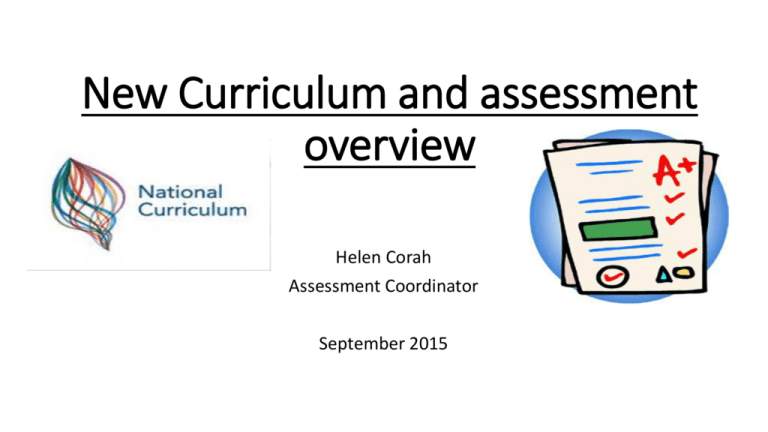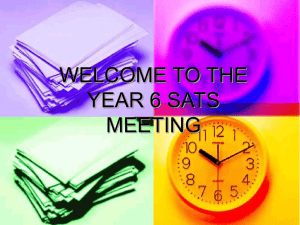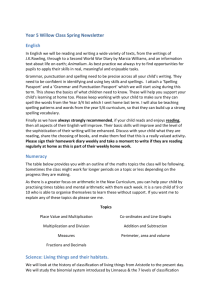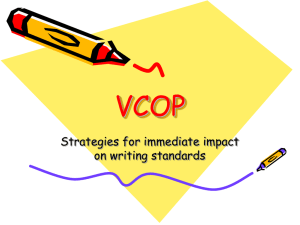New Curriculum and assessment overview
advertisement

New Curriculum and assessment overview Helen Corah Assessment Coordinator September 2015 New Primary Curriculum • Statutory for most year groups from September 2014. • Statutory for Year 2 and Year 6 as well this year. • The bar has been raised… • There are changes in content and expectations. A brief history of … The National Curriculum • 1988 Last National Curriculum introduced including Levels (only as end of Key Stage Benchmarks) • 1990 National Testing - SATs for 7 year olds • 1994 - SATs for 11 year olds • Sub levels developed (4c, 4b, 4a) • Push to improve 4 4b 5 6 (equivalent to GCSE grade D) • End result = huge spread of ability and not all “secondary ready” Why have the Government said that the National Curriculum needed to change? • First and foremost to raise standards. • UK seen to be falling behind other countries. • To be slimmed down… Research has shown the need to cover fewer things in greater depth. • Previous curriculum very content heavy – research has shown the need to return to the fundamental content. • Issues with the level system Children missing the boat Mind the gap! Deep and secure learning for all! What subjects make up the New Curriculum? Languages Also, we must make provision for SMSC (Spiritual, Moral, Social and Cultural Education) What do we mean by the core subjects? • • • • English Maths Spoken language Writing Reading Spelling, vocabulary, grammar and punctuation (SPAG). • Number and place value • Addition, subtraction, multiplication and division. • Fractions • Measurement • Geometry • Statistics. Science • Working scientifically, • Plants, animals (including humans), • Rocks, • Light, • Forces and magnets, • States of matter, • Electricity, • Properties and changes of materials, • Earth and Space, • Evolution and inheritance (Y6) Some of The main changes… • Stronger emphasis on vocabulary development, grammar, punctuation and spelling (for example, the use of commas and apostrophes will be taught in KS1) • Spelling word lists are included for Key Stage 2. • Handwriting –is expected to be fluent, legible and speedy • Spoken English has a greater emphasis, with children to be taught debating, recitation and presenting skills. • Strengthen the teaching of phonics - more pupils should read fluently. • Emphasis on reading more widely, for pleasure. Grammatical terms pupils should recognise, use and practise Year 2: Detail of content to be introduced (statutory requirement) Year 4: Detail of content to be introduced (statutory requirement) Grammatical terms pupils should recognise, use and practise Year 5: Detail of content to be introduced (statutory requirement) Year 6: Detail of content to be introduced (statutory requirement) Some of The main changes… • It goes beyond the previous curriculum. • Need to keep key maths fundamentals, such as times tables and number facts, "on the boil“ (All times tables and related division facts up to 12 x 12 known by Y4) • Emphasis on calculating and problem solving with fractions and decimals and less on data handling (now called statistics). • Calculators are banned in the KS2 SAT. There is an increased emphasis on mental fluency and the use of efficient written methods in the four mathematical operations. Content now in KS1 that used to be Year 3 • Use numbers and images to find a solution and present it in context, where appropriate using £.p notation or units of measure • Derive and recall all addition and subtraction facts for each number to 20, sums and differences of multiples of 10 and number pairs that total 100 • Derive and recall multiplication facts for the 2, 5 and 10 times-tables and the corresponding division facts • Add or subtract mentally combinations of one-digit and two-digit numbers • Multiply one- and two-digit numbers by 10, and describe the effect • choose and use appropriate units to estimate, measure, and record measurements • Read scales to the nearest whole digit • Read the time on a 12-hour digital clock and to the nearest five minutes on an analogue clock; calculate time intervals and find start or end times for a given time interval 2016 Year 6 testing arrangements English – one test for all • Grammar (36-50%), Punctuation (14-29%), Vocabulary (4-10%) and Spelling (29%)Tests – 45 +15 mins • Reading Tests - 60 mins • Writing is teacher assessed Maths • Paper 1 – Arithmetic (36 Qs) – 30mins • Paper 2 and paper 3 – both Mathematical reasoning (75 – 85% Number, ratio & algebra) – both 40 mins SAT scoring • Children will be presented with a standardised scaled score for these tests • 100 = Age Related Expectations (ARE) • More than 100 = above ARE (we think up to 135 ish) • Less than 100 = below ARE (we think down to 80 ish) W1 W2 W3 Also known as The Deeper Learning Model W1 W2 W3 So HOW do we assess? In school formative assessment • Questioning, marking, observations, recap quizzes, scanning work • RAG rating for each objective for each pupil on O Track (class track) • Provides on going, day to day and even within lesson monitoring of pupils’ strengths, weaknesses and next steps • Reported to parents to strengthen partnerships and aid learning • Communicated to pupils, providing targets and next steps • Acted on, in class, within the lesson, that afternoon or the next day • Shared with next teachers as shows exactly where gaps are In school summative assessment • Termly conversion to Deeper Learning ARE (Age Related Expectation) Judgement • Use combination of tests, teacher assessment, in class questioning and work analysis as well as suggestion from O-Track • Produces percentages of pupils on track to achieve ARE/ good progress by end of year • Analysed to provide information on in year progress of specific groups • Used to identify need for interventions • Information from this will inform parents’ meetings discussions in Spring Categorically, not accelerated learning. LWJ ideas of what might constitute mastery • • • • • • • • • Application of skill Out of context application Conscious design of own journey Reasoning, pattern spotting and explanation of relationships Drawing connections between strands of learning from different topics Ability to articulate/teach others Fluency in number facts and operations Foresight, predictions Abstract thinking e.g. net construction in tests/ visually internalised models ARE Writeways • Converted to include an ARE section of Year group specific skills • Mastery statements version available to demonstrate application of skills - transformation of bare bones, SPAG heavy skills into real writer skills • Produced in consultation with Year groups so statements are appropriately child friendly • Core skills (non-negotiables) added where necessary Conversion from levels to ARE • Needs to be a sticking plaster moment • We are converting all KS1 levels, Y3 entry levels and July 2015 levels to ARE in order to track progress • NB New standardised and externally analysed Year 3 Entry tests are being administered and external Writing Moderation sought to provide us with a watertight Year 3 Entry ARE/ baseline • Diagnostic NVR tests will still be carried out on all pupils End of Year Reports • Similar format as before • Communicate level of success at objectives for that Year group • Clear next steps • Overall rating of Below, W1, W2, W3, ARE or Mastery for each core subject Remember • Achieving ARE constitutes good attainment due to the challenge built into the curriculum W1 W2 W3 Also known as The Deeper Learning Model And over to you… • Any questions? • Any suggestions? How can we support you next? Workshop menu


![afl_mat[1]](http://s2.studylib.net/store/data/005387843_1-8371eaaba182de7da429cb4369cd28fc-300x300.png)





